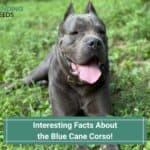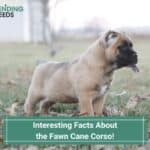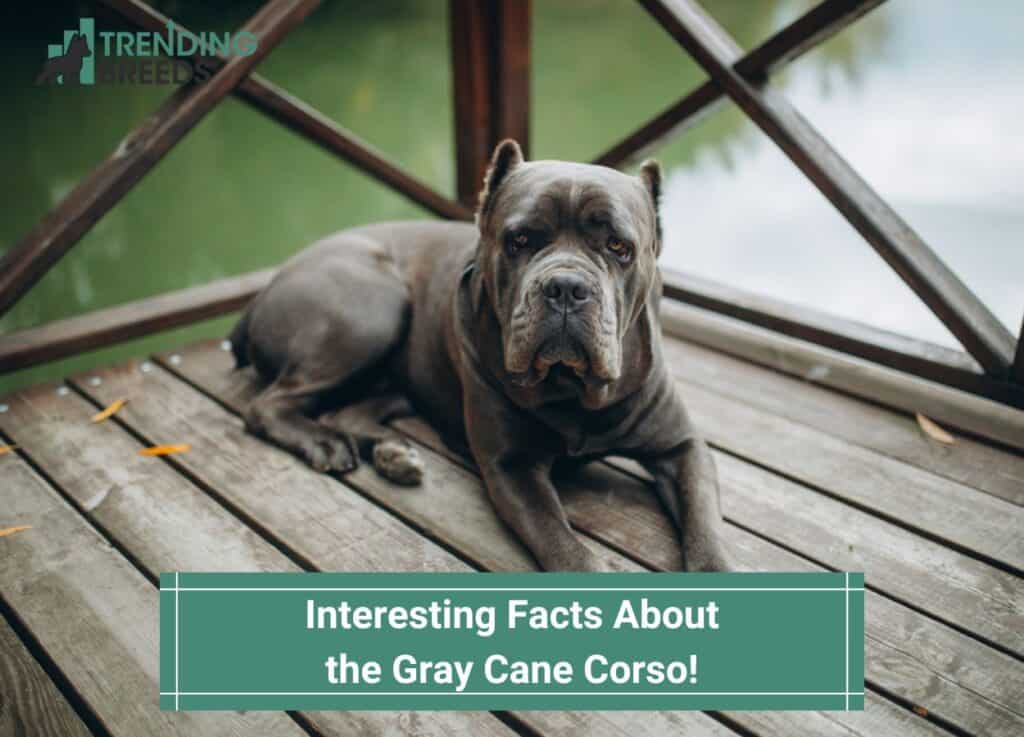
The Cane Corso isn’t one of the better known dog breeds. Originally from Italy, this breed is a rare and specialty dog. Unlike the German Shepherd or Golden Retriever, the Cane Corso is more of a “niche” choice of pet.
If you want an athletic dog and are an experienced dog owner, you could think about getting a Cane Corso. The following are 15 interesting facts about the gray Cane Corso.
List of the 15 Most Interesting Facts about the Gray Cane Corso
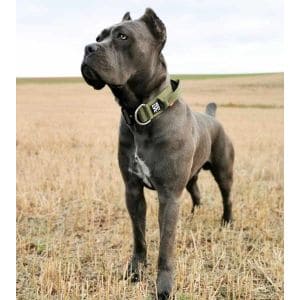
Other articles you would like: The Jaws And Bite Of A Cane Corso and Is Your Cane Corso Too Skinny?
Table of Contents
1. Gray Cane Corsos Are Rare
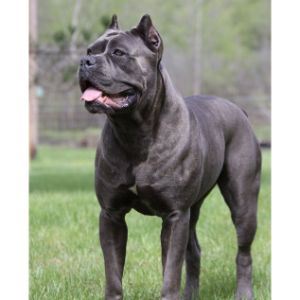
While black is the rarest Cane Corso color, gray is also hard to find. Cane Corsos are also bluish-gray in color and a true gray. Gray Cane Corsos, however, are more of a steel gray color.
As gray is a rare shade in this breed, you should expect to pay more. There are some shades that are rarer than gray, though, such as straw, liver, chocolate (or brown), and a shade we refer to as “Isabella.”
Sometimes, Cane Corsos that you think are gray are actually blue; they tend to have a blue hue to their coats.
Even Cane Corsos of other colors may have a gray (or black) “mask” on their faces. If you’re okay with your Cane Corso having a different color on its body and just a gray mask, maybe you could consider getting that variety of this breed.
For a Cane Corso to be considered a gray Cane Corso, though, it needs to be gray all over its body.
2. Gray Cane Corsos Are Strong and Powerful Dogs
Like all other Cane Corsos, gray Cane Corso are legendary for their strength. This breed’s bite force is genuinely extraordinary (and a little bit alarming)!
The Cane Corso’s bite force extends to about 700 PSI; this is stronger than a lion, which only has a 691 PSI. Yes, this potentially intimidating dog needs attentive training and socialization right from the very start.
Your gray Cane Corso might not be fond of strangers, so keep this in mind! The Cane Corso is affectionate with his own human companions, but he’ll be suspicious of anyone else coming into his territory. You’ll have to introduce the newcomers very carefully.
3. A Gray Cane Corso Puppy May Change Color

If you have your heart set on a gray Cane Corso, you should know that puppies with this coat can sometimes change color, and they could end up a darker gray or even a lighter shade as they age.
When a puppy’s coat color changes, it happens slowly. So, don’t expect to see its color change overnight. If you get a gray Cane Corso puppy and the color changes, it’ll probably keep the same or a similar tone and just dark or get lighter.
4. The Gray Cane Corso Coat Is Caused by a Recessive Gene
Specifically, the gray Cane Corso coat is due to a recessive dilute gene. This gene reduces how much eumelanin the dog can produce.
Eumelanin is the pigment that creates black in a canine’s coat. When this pigment becomes diluted because of the recessive gene we discussed, what would otherwise be black hair becomes gray.
It’s possible to get a gray puppy from black Cane Corso parents, but only if both the mother and father have this recessive gene.
5. Gray Cane Corsos Have an Ancient History and Italian Origin
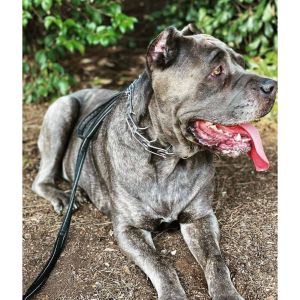
The Cane Corso is an ancient breed; the Cane Corso dates back thousands of years as there is proof they lived in Ancient Rome.
In fact, its ancestor was probably a breed called the Greek Molossus dog; that breed existed in ancient Greece and is no longer around today.
Today, we know the Cane Corso as an Italian breed. We’re lucky it still exists, as it came close to extinction in the mid-20th century. Cane Corsos of all coat types are from Italy.
6. You Probably Shouldn’t Get a Gray Cane Corso if You Have Young Kids
Many dog breeds are great with kids but generally speaking, the Cane Corso isn’t one. Well-socialized Cane Corsos who are around kids from when they’re a puppy might be great family dogs.
A Cane Corso just doesn’t have the patience that other dogs have, and it’s difficult for them to behave well when they’re around unpredictable children.
If you have older kids, you might be able to get a Cane Corso but make sure you socialize him with your children from the time it’s a puppy.
7. Cane Corsos Are in the Mastiff Family
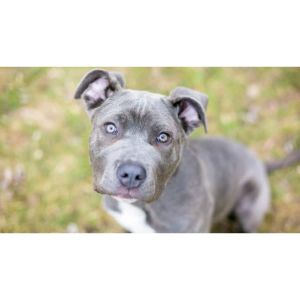
The Cane Corso is related to the Mastiff. Have you ever seen a Neapolitan Mastiff? It’s a cousin to the Cane Corso.
Specifically, the Cane Corsos ancestors were Mastiffs and some people today call the Cane Corso the Italian Mastiff. Like other Mastiffs, the Cane Corso was originally a hunting and guard dog.
Today, there are many types of Mastiff dogs. As well as the Cane Corso and Neapolitan Mastiff, some well-known ones are the Mastiff, Bullmastiff, and Tibetan Mastiff.
One of the standard features across all Mastiffs is their power, strength, and protective and territorial instincts.
8. A Male Gray Cane Corso Weighs Between 90 and 110 Pounds
Maybe you don’t think that 90 to 110 pounds sounds large, but it’s almost all muscle when it comes to the Cane Corso.
Female Cane Corsos weigh a little bit less. The average adult weight of a female in this breed is between 88 and 99 pounds.
Don’t underestimate the Cane Corso just because some other dogs weigh more. This breed has almost unmatchable strength.
9. There Are Gray Brindle Cane Corsos
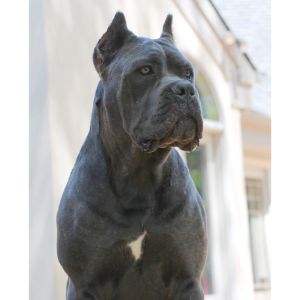
A gray brindle Cane Corso is a striking-looking animal. The base color of the Cane Corso is brown or light brown, and the gray comes in with stripes. There are usually blue-tinted stripes, too.
If you’re like many people, you’re probably wondering what the word “brindle” means, exactly. Well, it means that a dog has visible stripes in its coat.
The stripes aren’t distinctive like tiger stripes. Instead, they’re quite subtle and you need to get close to the coat before you can really notice them.
Gray brindle Cane Corsos are even rarer than Cane Corsos with a solid gray coat. This is a little less common than other scenarios, but it is possible for a solid gray Cane Corso puppy to end up with a brindle coat.
10. Gray Cane Corsos Are Also Called Silver Cane Corsos
If you hear anyone talking about a silver Cane Corso, they’re talking about a gray Cane Corso. This title makes sense, as the gray Cane Corso’s coat has a distinctly silver-gray appearance.
Blue Cane Corsos that we sometimes think look grayish; however, they have a blue rather than gray look.
11. The Cane Corso Has a Short Coat
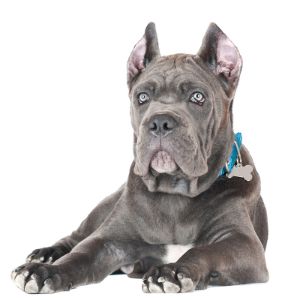
One advantage of the Cane Corso is its short coat. Your gray Cane Corso has a double coat, which means it has an undercoat and a top coat.
The top coat consists of stiff hairs that only grow short. While you’ll like how the hairs won’t tangle, you should know this dog does shed quite a bit.
The shedding is because the breed has an undercoat that it sheds depending on the season.
If you plan to bring your gray Cane Corso to a groomer, you’ll have to get him used to it as a puppy. Remember, Cane Corsos aren’t all that friendly to strangers, and their size and strength can be intimidating.
12. Only Experienced Dog Owners Should Get This Breed
You probably shouldn’t consider a gray Cane Corso (or any Cane Corso) if you’re a first-time dog owner. You must be experienced at training and handling dogs to do well with this breed because of this canine’s strength and temperament.
You’re definitely not dealing with a Golden Retriever here. The Cane Corso is a stubborn dog who can be aggressive if not properly socialized.
Remember, purchasing a dog is a big responsibility. Don’t jump into a decision without doing your research and finding the breed that is right for you.
You want your home to be a “forever home” for your canine, and Cane Corsos tend to live between 9 and 12 years.
13. Gray Cane Corsos Have a Significant Prey Drive
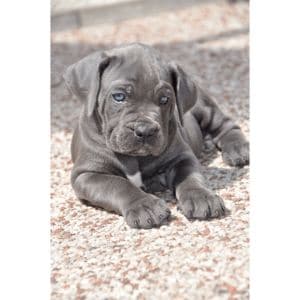
You shouldn’t have small animals, such as cats, around any kind of Cane Corso. The Cane Corso has an alarming prey drive compared to many other breeds. Remember, hunting was one of this breed’s original purposes.
This prey drive can also make Cane Corsos dangerous around children, especially if they’re not well-socialized.
No doubt about it, this is an intimidating dog. From its enormous head and face to its muscular and powerful body, this dog isn’t for the faint of heart!
If you get a Cane Corso, make sure you start socializing it from the very beginning. Thorough socialization is key for any breed, but it’s especially vital with such a strong and potentially aloof and stubborn dog.
14. This Breed Loves Hiking
Looking for a dog breed that loves going for long walks and hikes? The Cane Corso, including the gray Cane Corso, loves to walk with his human companions.
Make sure to keep him on the leash at all times! This dog breed can be aggressive towards strangers, and you don’t want your Cane Corso chasing (and potentially attacking) a fellow hiker!
As well as hiking, Cane Corsos love spending time just exercising and playing with their humans. If you have a backyard, make sure there’s a secure fence.
15. Cane Corsos Do a Lot of Vocalization
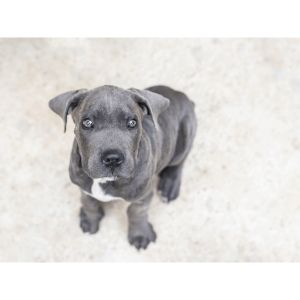
While many dog breeds vocalize, the Cane Corso is especially notable for this. Cane Corsos make several different kinds of vocalizations, including a “roo-roo” noise, snuffling, snorting, and more.
The roo-roo noise is unique, sounding a bit like barking but also a bit like singing.
So, be ready for a talkative and communicative dog if you get a Cane Corso. This dog is extremely sociable with the human companions it knows well.
Conclusion For “Interesting Facts About the Gray Cane Corso!”
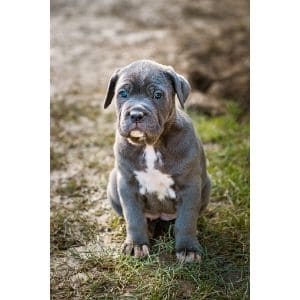
While the gray Cane Corso is a strong, powerful, and unique dog with many interesting characteristics. This dog breed has had a presence throughout history and isn’t the kind you come across every day.
You’ll need a lot of experience as a dog owner and knowledge of dog training before you consider getting this breed.
As the gray Cane Corso is one of the rarest varieties of this breed, you’ll have to spend a lot of time looking to find one of these puppies.
Before bringing a gray Cane Corso (or any Cane Corso) into your home, be sure to do your research to establish whether this dog breed is right for you.
You will also like:
For more information about the Cane Corso Breed, check out the video below:


